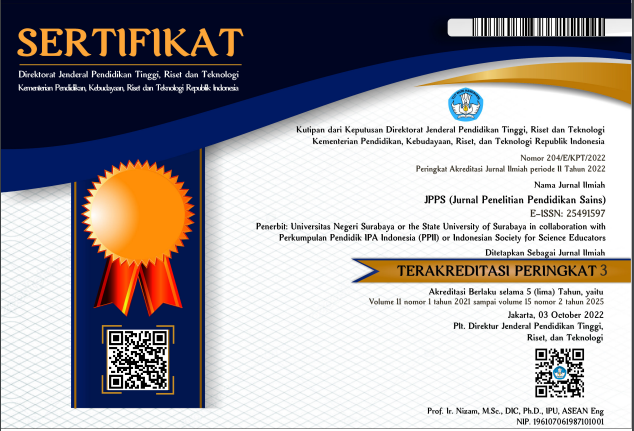How the Evolution and Track of Several Digital Technologies in Science Education?
DOI:
https://doi.org/10.26740/jpps.v13n2.p113-128Keywords:
Bibliometric, Digital Technologies, Literature Review , Science EducationAbstract
Objective: Digital technologies have significantly impacted science education. This research uses a bibliometric analysis to analyze the evolution of various digital technologies in science education. Method: The research uses the PRISMA method to conduct a systematic review using the Scopus database. Results: LMS was the highest publication and citation in the last five years. DL and LMS publications increased, but DA decreased. DL, LMS, DA, and EA publications dominate article papers. SC and ILS dominated conference papers. 57% of DT researchers are European, with 19% from Asian and North American researchers. Twenty-four sources are participating in DT research. Many universities in America, such as Harvard University, Stanford University, MIT, and Berkeley University, the University of California have extensive facilities for participating in DL, LMS, DA, EA, SC, and ILS research. Novelty: This research is essential to educators, researchers, and policymakers to provide insights on improving digital teaching technologies, inform policy, and promote interdisciplinary collaboration. It also offers an overview and research trend of DT in science education research and its opportunities for researchers, librarians, digital developers, educators, and policymakers to develop further research, education, and technology. Further research can be conducted based on the scope of mathematics or physics education, especially to investigate specific skills or STEAM.
Downloads
References
Alam, A. (2022). Educational robotics and computer programming in early childhood
Aliyyah, R. R., Rasmitadila, Fauziah, S. P., Widyasari, Marini, A., & Ruhimat. (2024).
Ameli, F. (2020). Teaching and learning for the twenty-first century: educational goals, policies,
and curricula from six nations: edited by FM Reimers and CK Chung, Cambridge, MA, Harvard Education Press, 2016, 304 pp., US $34 (paperback), ISBN 978-1-61250-922-8. Taylor & Francis.
science and social science research landscape. Sustainability, 12(21), 9132. https://doi.org/10.3390/su12219132
mathematical proficiency. University of Glasgow.
Berchin, I. I., Sima, M., de Lima, M. A., Biesel, S., dos Santos, L. P., Ferreira, R. V., de
Bielecka, E. (2020). GIS spatial analysis modeling for land use change. A bibliometric
analysis of the intellectual base and trends. Geosciences, 10(11), 421. https://doi.org/10.3390/geosciences10110421.
development of ESD methodologies. Sustainability, 12(7), 3010. https://doi.org/10.3390/su12073010.
Chassignol, M., Khoroshavin, A., Klimova, A., & Bilyatdinova, A. (2018). Artificial
Cress, T., & Kalthoff, H. (2023). Hybrid Imbalance: Collaborative Fabrication of Digital
Dede, C., & Lidwell, W. (2023). Developing a next-generation model for massive digital
learning. Education Sciences, 13(8), 845. https://doi.org/10.3390/educsci13080845.
Farooq, R. (2023). Knowledge management and performance: a bibliometric analysis
Haleem, A., Javaid, M., Qadri, M. A., & Suman, R. (2022). Understanding the role of
Heradio, R., Perez-Morago, H., Fernandez-Amoros, D., Cabrerizo, F. J., & Herrera-
Hernandez-de-Menendez, M., & Morales-Menendez, R. (2019). Technological
Horbach, S. ( S., & Halffman, W. ( W. (2018). The changing forms and expectations of peer
Islam, M. M., Chowdhury, M. A. M., Begum, R. A., & Amir, A. A. (2022). A
Lembani, R., Gunter, A., Breines, M., & Dalu, M. T. B. (2020). The same course, different
Li, K. C., & Wong, B. T.-M. (2022). Research landscape of smart education: a bibliometric
Marks, B., & Thomas, J. (2022). Adoption of virtual reality technology in higher education:
McDaniel, K. G., Brown, T., Radford, C. C., McDermott, C. H., van Houten, T., Katz, M.
Miller, T. (2019). Explanation in artificial intelligence: Insights from the social sciences.
Nami, F. (2020). Educational smartphone apps for language learning in higher education:
Norton, J. C., Politis, M. D., Bimali, M., Vyas, K. S., Bircan, E., Nembhard, W. N., Amick,
Oliveira, G., Grenha Teixeira, J., Torres, A., & Morais, C. (2021). An exploratory study on
Oyewola, D. O., & Dada, E. G. (2022). Exploring machine learning: a scientometrics
approach using bibliometrix and VOSviewer. SN Applied Sciences, 4(5), 143. https://doi.org/10.1007/s42452-022-05027-7.
Peng, X., & Dai, J. (2020). A bibliometric analysis of neutrosophic set: two decades review
Pham, P.-T., Lien, D. T. H., Kien, H. C., Chi, N. H., Tinh, P. T., Do, T., Nguyen, L. C., &
Radanovi?, I., & Liki?, R. (2018). Opportunities for use of blockchain technology in
https://doi.org/10.1007/s40258-018-0412-8.
Rajan, K. K., & Pandit, A. S. (2022). Comparing computer-assisted learning activities for
learning clinical neuroscience: A randomized control trial. BMC Medical Education, 22(1), 522. https://doi.org/10.1186/s12909-022-03578-2.
Rethlefsen, M. L., Kirtley, S., Waffenschmidt, S., Ayala, A. P., Moher, D., Page, M. J., &
Robinson-Garcia, N., Mongeon, P., Jeng, W., & Costas, R. (2017). DataCite as a
Bouix-Picasso, J. (2019). Effects of e-learning in a continuing education context on nursing care: systematic review of systematic qualitative, quantitative, and mixed-studies reviews. Journal of Medical Internet Research, 21(10), e15118. https://doi.org/10.2196/15118.
Schoeneberger, C. A., McMillan, C. A., Kurup, P., Akar, S., Margolis, R., & Masanet, E.
(2020). Solar for industrial process heat: A review of technologies, analysis approaches, and potential applications in the United States. Energy, 206, 118083. https://doi.org/10.1016/j.energy.2020.118083.
Shvets, O., Murtazin, K., & Piho, G. (2020). Providing feedback for students in e-learning
Singh, H., & Miah, S. J. (2020). Smart education literature: A theoretical analysis. Education
Smith, N. (2018). Integrating Gamification into Mathematics Instruction: A Qualitative
Exploratory Case Study on the Perceptions of Teachers at the Fourth and Fifth Grade Level. Online Submission.
Wang, S., Chen, Y., Lv, X., & Xu, J. (2023). Hot topics and frontier evolution of science
Wu, S. P. W., & Rau, M. A. (2019). How students learn content in science, technology,
Zhong, J., & Zheng, Y. (2022). Empowering future education: Learning in the Edu-
Downloads
Published
How to Cite
Issue
Section
License
Copyright (c) 2024 JPPS (Jurnal Penelitian Pendidikan Sains)

This work is licensed under a Creative Commons Attribution-ShareAlike 4.0 International License.
 Abstract views: 241
,
Abstract views: 241
, PDF Downloads: 344
PDF Downloads: 344












